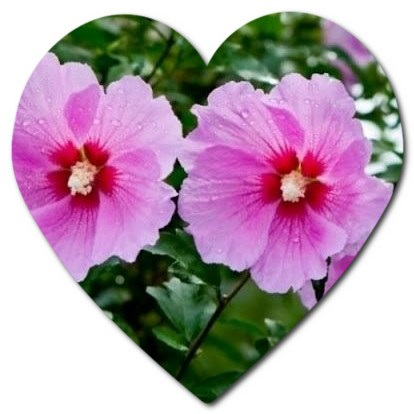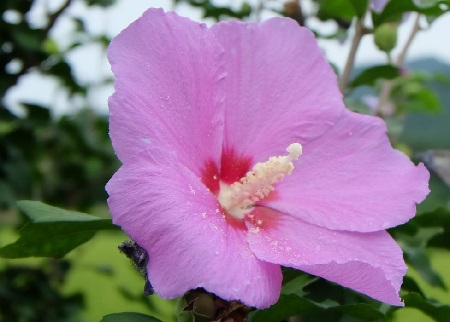The national flower of South Korea is the Rose of Sharon, which is also known by its scientific name, Hibiscus syriacus. In South Korea, it is called “Mugunghwa” (무궁화), which translates to “eternal flower.” The Rose of Sharon holds cultural and historical significance in South Korea and is often used as a symbol of the country and its enduring spirit. It can be found on the South Korean national emblem and is celebrated in various forms of art, literature, and culture.
Hibiscus syriacus, known as the Rose of Sharon or Mugunghwa (무궁화) in Korean, is a native plant to South Korea, and it can be found growing in various regions throughout the country. South Korea has a diverse climate and landscape, which allows the Rose of Sharon to thrive in different environments.
Information about the national flower of South Korea
The Rose of Sharon (Hibiscus syriacus), known as “Mugunghwa” (무궁화) in Korean, is the national flower of South Korea. Here are some key points about this beautiful and significant flower:

- Cultural Significance: The Rose of Sharon is deeply embedded in South Korean culture and history. It is often seen as a symbol of the Korean people and their enduring spirit, particularly in the face of adversity.
- National Emblem: The Mugunghwa can be found on the national emblem of South Korea, where it is surrounded by five petals representing the five cardinal virtues of Confucianism: humanity, righteousness, propriety, wisdom, and trust.
- Endurance and Resilience: The Rose of Sharon is appreciated for its hardiness and ability to bloom in a wide range of conditions. This resilience is seen as a reflection of the Korean people’s own resilience and perseverance.
- Seasonal Beauty: The Mugunghwa is known for its large and showy flowers, which come in various colors, including shades of pink, purple, and white. It typically blooms during the summer months, adding color and beauty to the South Korean landscape.
- Art and Literature: The Rose of Sharon has been a popular subject in South Korean art, literature, and poetry. It is often used as a symbol of love, purity, and the beauty of the Korean landscape.
- Celebratory Days: South Korea celebrates “Mugunghwa Day” on May 1st each year, which is dedicated to the national flower. This day is marked by various events, cultural activities, and educational programs that highlight the significance of the Rose of Sharon.
- National Pride: The Mugunghwa is a source of national pride and a unifying symbol for the people of South Korea. It is a reminder of the country’s heritage and its ability to thrive and prosper, even in challenging times.
The Rose of Sharon, or Mugunghwa, is not only a botanical symbol but also a cultural and historical emblem that holds a special place in the hearts of the South Korean people.
How to care for the Hibiscus syriacus flower
Hibiscus syriacus, commonly known as the Rose of Sharon, is a beautiful flowering shrub that can be cared for with some attention to its specific needs. Here are some tips on how to care for this plant:

- Planting: When initially planting the Rose of Sharon, choose a well-draining soil with good organic content. It should be planted in a location that receives at least 6-8 hours of direct sunlight per day.
- Watering: Hibiscus syriacus prefers consistent moisture but does not like to be waterlogged. Water the plant deeply when the soil is dry to the touch, but avoid overwatering. During hot and dry spells, it may need more frequent watering.
- Mulching: Apply a layer of organic mulch around the base of the plant to help retain soil moisture, suppress weeds, and regulate soil temperature.
- Pruning: Prune your Rose of Sharon in the late winter or early spring to encourage new growth and maintain a desired shape. Remove any dead or diseased branches. The plant can tolerate heavy pruning.
- Fertilizing: Fertilize the plant in the spring with a balanced, slow-release fertilizer. Avoid excessive use of high-nitrogen fertilizers, as this can lead to excessive foliage growth at the expense of flowers.
- Pest and Disease Control: Keep an eye out for common pests such as aphids and spider mites. If you notice an infestation, you can use insecticidal soap or neem oil to control them. Also, watch for signs of fungal diseases like powdery mildew and treat them with appropriate fungicides if needed.
- Winter Care: In colder regions, Rose of Sharon may benefit from some winter protection, like a layer of mulch or burlap wrapping, to shield it from harsh winter conditions.
- Deadheading: Deadhead spent flowers to encourage more blooms throughout the growing season.
- Propagation: If you want to propagate your Rose of Sharon, you can do so by taking softwood cuttings in early summer or semi-hardwood cuttings in late summer or early autumn.
- Container Gardening: If you’re growing Rose of Sharon in a container, ensure the pot has good drainage, and use a quality potting mix. Container plants may require more frequent watering.
- Dormancy: Rose of Sharon is deciduous and may drop its leaves in the winter. This is a normal part of its growth cycle. Do not be alarmed; it should regrow leaves in the spring.
By following these care guidelines, you can enjoy the beauty of the Rose of Sharon and help it thrive in your garden. Keep in mind that local climate and soil conditions may influence the specific care requirements, so it’s a good idea to adapt your care routine to your particular growing environment. South Korea’s most popular flower >>
